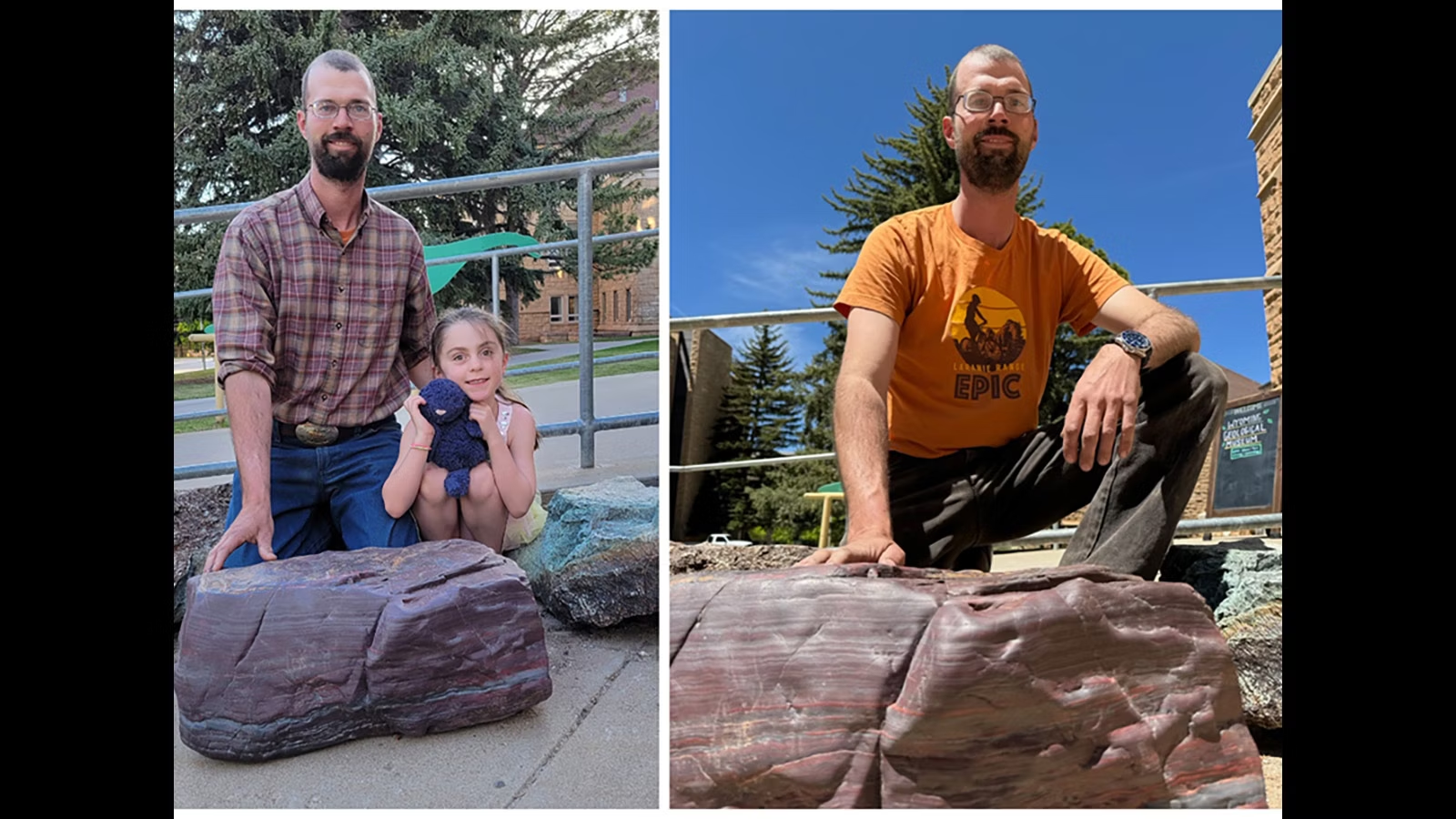A Cowboy State father-daughter duo didn’t know it at the time, but the big boulder they found is a huge discovery that’s 2.5 billion years old and a one-of-a-kind find for Wyoming rock hounds.
The sizeable stone found by Laramie resident Patrick Corcoran and his daughter Cora is called a banded iron formation. It’s from an important moment in Earth’s history, having been formed in the ancient oceans that covered Wyoming more than 2.5 billion years ago.
"I've never seen one this big in my time in Wyoming," said Dr. Laura Vietti, the geological museum and collections manager for the University of Wyoming, where the Corcorans donated their find. "It's really helpful to have vested supporters of the museum like Patrick and Cora because they were able to find this rare specimen and bring it to us."
The large rock certainly stands out, with a reddish color and relatively smooth and shiny with clearly visible bands formed over millions of years of sedimentary compression. For those who don’t know it on sight, it could be mistaken for a giant chunk of petrified wood.
Rusting The Oceans
Banded iron formations are unique sedimentary rocks that formed more than 2 billion years ago. The formation gets its name from the distinctly colored layers strikingly visible in the boulder found by the Corcorans.
"It's composed of alternating layers of a sparkly metal, usually hematite, and a red chert that alternates over and over," Vietti said. "And that's why it's called a banded iron formation."
The alternating bands of hematite and chert chronicle an important chapter of Earth's history. Banded iron formations are the earliest evidence of oxygen in the oceans, forming the foundation for multicellular life on the planet.
"Before multicellular life evolved on Earth, the atmosphere was very low in oxygen, and the oceans had no dissolved oxygen," she said. "When photosynthetic cyanobacteria started evolving and pumping out oxygen into the ocean and the atmosphere, it essentially rusted the oceans."
Since iron doesn't dissolve in water, all the rust floating in the ocean settled to the seafloor and formed thin but widespread banded iron formations. The reddish color of the UW specimen comes from the 2-billion-year-old rust created by cyanobacteria oxygenating the oceans and atmosphere that make our planet habitable today.

Cobbling Along
Banded iron formations can be found on every continent on Earth, including Wyoming. But that doesn't mean they're easy to find and often aren't in the Cowboy State.
"We have the right age of rocks and the right depositional environments to form banded iron formations," Vietti said. "But they're not easy to get to, and there's not a lot of them."
Most of Wyoming's banded iron formations are exposed at the highest points of mountain ranges, inaccessible to most except the most tenacious climbers. And there is little interest in getting to those deposits since banded iron formations aren't an economically viable resource.
The Corcorans found their 2-billion-year-old boulder in the flat expanse of a private ranch with nary a mountain in sight. Vietti classified their find as an outwash cobble that made a wet descent from a mountain exposure.
"Outwash cobbles were captured from the mountains by streams or glaciers," she said, "and tumbled their way down the mountains and deposited on the flats of Wyoming. You'll find them while you're walking across the prairie. That's where the majority of our banded iron comes from."
Tumbling through water and ice rounded and smoothed the boulder's jagged edges, revealing the dramatically colored layers. It's a perfect piece for the UW Geological Museum, and it’s already found a perfect place for it.

Bigger Is Better (Outside)
The UW Geological Museum has several specimens from banded iron formations collected in Wyoming. Two small pieces will be featured in "Wyoming's Oceans," a new exhibit at the museum showcasing Wyoming's watery past while highlighting the collections and research of the university's past and present biologists, geologists, and paleontologists.
The Corcorans' banded iron boulder is significant because of its size. Vietti said it's the largest Wyoming specimen she's seen in her career.
"Most of the banded iron formation cobbles you get in Wyoming are between the size of a thimble and a grapefruit," she said. "This particular specimen is really important because it's so big and shows the unique banded iron layers very well."
This specimen of Wyoming banded iron is slightly smaller than a mini fridge, and much heavier. Since the design of "Wyoming's Oceans" has already been finalized, the Corcoran's banded iron boulder is too big and too late to the party to be included in the new exhibit.
Vietti envisioned an academic future for the acquisition.
"It's going to be a display specimen, but mostly outside for now," she said. "We'll have a sign or some label attached to it for the general public. And it will be used as a teaching specimen for our Intro to Geology labs (at UW.)."
Patrick and Cora Corcoran are thrilled their big boulder has a promising future ahead of it, regardless of its location. It's survived two billion years of Wyoming's geologic history, so it shouldn't have any trouble enduring the natural forces of a university campus.
"It's awfully heavy and awfully big," Vietti said. "We don't really have space for it in the museum right now. We may put it inside in the future, but I think for right now, it will be happy outside. And we're very happy to have it there."
Andrew Rossi can be reached at arossi@cowboystatedaily.com.





